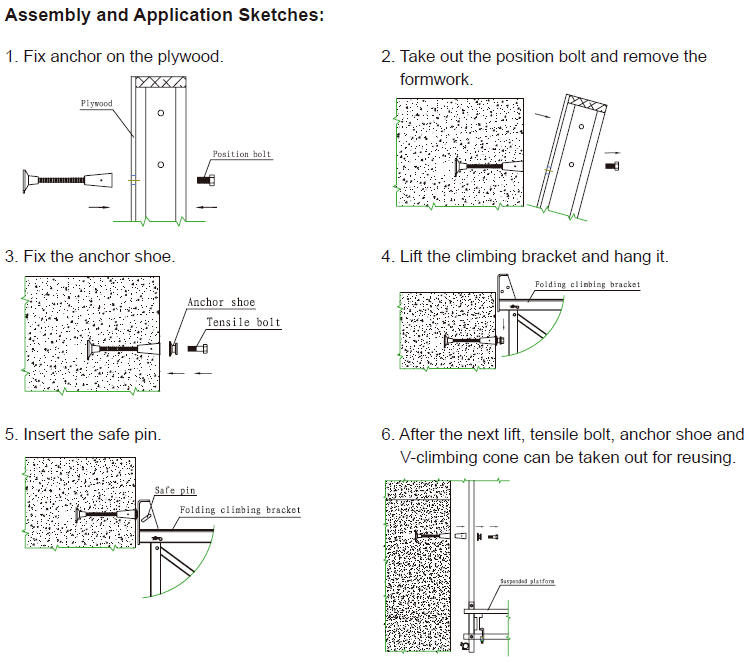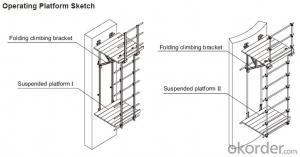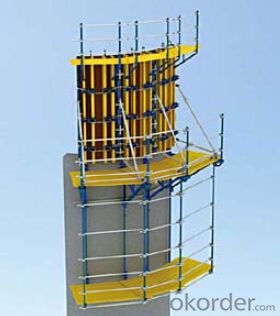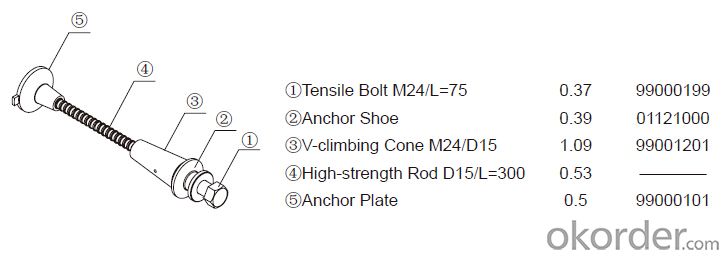Climbing Platform CP 190 for formwork and scaffolding system
- Loading Port:
- Tianjin
- Payment Terms:
- TT OR LC
- Min Order Qty:
- 50 m²
- Supply Capability:
- 1000 m²/month
OKorder Service Pledge
OKorder Financial Service
You Might Also Like
Climbing Platform CP190
Climbing bracket CP190 is mainly used as operating platform during construction. It can be used
on the vertical wall and arced wall. The bracket hang on the anchor system and all the load are
supported by anchor system. It’s convenient to assemble and dismantle, the construction is easy,
rapid and safe.
Anchor System:
Anchor system is the most important supporting part. The system is made of five parts shown
below. There into, tensile bolt, anchor shoe and V-climbing cone can be taken out for reusing.

- Q: How does steel formwork affect the overall construction project management?
- The overall management of a construction project can be greatly influenced by the use of steel formwork. The following are several ways in which it can affect project management: 1. Enhanced time efficiency: Steel formwork is renowned for its durability and ability to be reused, resulting in time savings during construction. By properly planning and coordinating, steel formwork can be easily assembled and disassembled, thus facilitating faster progress in construction. This increased time efficiency can lead to improved project scheduling and overall project management. 2. Cost-effectiveness: Despite potentially having a higher initial cost compared to other formwork materials, steel formwork's reusability makes it a cost-effective choice in the long term. Consequently, project managers can allocate their budget more efficiently, reducing unnecessary expenses and ensuring that the project remains within the designated cost limits. 3. Quality control: Steel formwork provides a smooth and uniform finish to concrete structures. This enables project managers to maintain high-quality standards throughout the construction process. By utilizing steel formwork, project managers can ensure that the final product meets the required specifications and standards, thereby minimizing the need for rework and potential delays. 4. Safety and durability: Due to its strength and stability, steel formwork is a safe option for construction projects. Its robustness helps prevent on-site accidents and creates a secure work environment for construction workers. Additionally, the durability of steel formwork ensures its ability to withstand the pressures exerted during the concrete pouring process, reducing the risk of structural failures and subsequent rework. 5. Flexibility and adaptability: Steel formwork offers a high level of flexibility, allowing project managers to adapt to changes and modifications in construction plans. Whether it involves adjusting the formwork design or reusing the same formwork for different parts of the project, the flexibility of steel formwork enables project managers to promptly respond to unforeseen circumstances, thereby minimizing disruptions to the project. In conclusion, steel formwork significantly impacts overall construction project management by enhancing time efficiency, cost-effectiveness, quality control, safety, and flexibility. Its durability and reusability make it an invaluable asset for project managers, enabling them to deliver projects on time, within budget, and to the desired quality standards.
- Q: How does steel formwork accommodate for different concrete compaction methods?
- Steel formwork is an adaptable construction material capable of accommodating various concrete compaction methods with ease. Its strength and rigidity are key advantages, allowing it to withstand the forces exerted during compaction techniques. When utilizing compaction methods such as hand tamping or a vibrating poker, steel formwork provides a stable and secure surface for applying the necessary forces. The rigid and tightly connected steel panels ensure that the concrete remains in place and maintains its shape throughout the compaction process. This facilitates efficient and effective compaction, resulting in a uniform and high-quality concrete finish. In instances where mechanical compaction methods such as plate compactors or vibrating rollers are employed, steel formwork readily adapts to the added weight and vibrations. The robustness of the steel panels enables them to support heavy equipment and absorb vibrations without deformation or cracking. This guarantees even compaction of the concrete, eliminating any potential weak spots or voids. Moreover, steel formwork can be easily adjusted and modified to accommodate diverse compaction methods. The panels can be effortlessly repositioned or removed to allow proper access and movement for compaction equipment. Additionally, steel formwork can be tailored to specific shapes and sizes to meet the requirements of the compaction method employed. In summary, steel formwork offers a dependable and flexible solution for accommodating various concrete compaction methods. Its strength, rigidity, and adaptability make it an ideal choice for construction projects that necessitate efficient and effective compaction techniques.
- Q: How are steel formwork panels connected together?
- To create a sturdy and stable structure for pouring concrete, steel formwork panels are joined together using various methods. One commonly employed technique involves the use of steel pins or bolts, which are inserted into pre-drilled holes in the panels. These pins or bolts are then tightened or secured with nuts, ensuring a firm connection between the panels. Another approach involves the utilization of clamps or couplers, which are positioned along the edges of the panels and tightened to hold them in place. These clamps or couplers can be easily adjusted or removed, allowing for flexibility in the formwork system. Furthermore, certain steel formwork panels possess interlocking mechanisms like slots or hooks, which enable effortless alignment and connection. These interlocking features facilitate a seamless connection between the panels, resulting in a smooth and uninterrupted surface for pouring concrete. In conclusion, the connection of steel formwork panels is vital for preserving the integrity and stability of the formwork system during the concrete pouring process. The chosen method of connection depends on the specific design and requirements of the project, as well as the type of steel formwork being utilized.
- Q: Can steel formwork be easily transported to different job sites?
- Yes, steel formwork can be easily transported to different job sites. Steel formwork is known for its durability and strength, making it suitable for repeated use and easy transportation. It can be disassembled and reassembled without losing its structural integrity, allowing it to be easily transported to different locations. Additionally, steel formwork is lightweight compared to other types of formwork, making it easier to handle and transport using regular construction machinery or vehicles. Its versatility and transportability make steel formwork a popular choice for construction projects that require frequent movement between job sites.
- Q: What are the different finishes available for steel formwork?
- Some of the different finishes available for steel formwork include smooth, textured, brushed, and galvanized finishes. Each finish serves a specific purpose and can be chosen based on the desired appearance, durability, and functionality of the steel formwork.
- Q: What are the different types of ties used with steel formwork?
- Steel formwork utilizes various types of ties to meet the specific needs of each construction project. The commonly employed tie options include: 1. Snap Ties: This fundamental and widely adopted tie type consists of a rod and a flat plate connected by a snap tie wedge. Snap ties securely fasten formwork panels for straight walls. 2. Coil Ties: These ties resemble snap ties but possess a more flexible design. Comprising a rod with a coil at one end and a flat plate at the other, coil ties are ideal for curved or irregularly shaped walls due to their easy installation and removal capabilities. 3. She-Bolts: She-bolts are threaded rods equipped with a flat plate and a nut. They serve to connect steel formwork panels and are commonly utilized for large panels or when supporting high loads is necessary. 4. Tie Rods: Tie rods are employed to secure formwork panels. They consist of lengthy threaded rods passing through the panels and are fastened with nuts and washers on both ends. Tie rods are often used in conjunction with other tie types to enhance formwork stability and support. 5. Wing Nuts: Wing nuts work in tandem with tie rods to firmly secure formwork panels. Their wing-shaped design allows for effortless manual tightening and loosening without the need for additional tools. Wing nuts are frequently utilized for vertical formwork applications. 6. Cone Anchors: Cone anchors are instrumental in anchoring the formwork system to the concrete structure. They consist of a cone-shaped anchor attached to a threaded rod, which is inserted into a pre-drilled hole in the concrete. Cone anchors establish a robust and dependable connection between the formwork and the concrete. These examples represent only a fraction of the diverse ties employed in steel formwork. Selecting the appropriate tie system depends on variables such as formwork shape and size, load requirements, and the specific construction project. It is crucial to consult with a structural engineer or formwork expert to determine the most suitable tie system for a given application.
- Q: What are the different types of surface treatments available for steel formwork?
- There are several types of surface treatments available for steel formwork, including galvanizing, epoxy coating, powder coating, and paint. Galvanizing involves coating the steel with a layer of zinc to provide corrosion resistance. Epoxy coating provides a durable and smooth surface that is resistant to chemicals and moisture. Powder coating is a dry finishing process that creates a decorative and protective layer on the steel. Paint can also be used as a surface treatment to provide protection against corrosion and enhance the appearance of the steel formwork.
- Q: How does steel formwork affect the overall weight of the structure?
- Steel formwork can significantly affect the overall weight of a structure as it is typically heavier than other types of formwork materials such as wood or aluminum. The weight of steel formwork can increase the dead load on the structure, potentially requiring additional structural support and impacting the design and construction process. However, steel formwork offers advantages in terms of durability, strength, and reusability, making it a preferred choice in certain construction projects despite its impact on the overall weight.
- Q: How does steel formwork contribute to the overall accuracy of concrete placement?
- There are several ways in which steel formwork contributes to the accuracy of concrete placement. Firstly, it provides a strong and stable structure, ensuring that the concrete is poured and cured in the desired shape and dimensions. The steel panels are designed to be resistant to deformation, reducing the risk of the formwork shifting or warping during pouring. Moreover, steel formwork allows for precise control over alignment and leveling. The panels can be easily adjusted and secured, ensuring that the concrete is poured at the intended level and alignment. This is particularly important for projects that require high accuracy, such as those with intricate architectural designs or precise measurements. Additionally, steel formwork offers the advantage of reusability. Unlike traditional wooden formwork, which can only be used a limited number of times, steel formwork can be used multiple times without compromising its structural integrity. This contributes to cost-effectiveness and consistent accuracy in concrete placement across various projects. Furthermore, the smooth surface of steel formwork helps achieve a high-quality finish on the concrete surface. The smooth panels minimize the risk of surface imperfections, ensuring a consistent texture and appearance. This is especially important for projects where the concrete will be exposed, such as architectural features or decorative elements. In conclusion, steel formwork is essential for maintaining accuracy in concrete placement. Its rigidity, adjustability, reusability, and smooth surface all contribute to achieving precise dimensions, alignment, and finish. This makes steel formwork a vital tool in construction projects that require high levels of accuracy and quality.
- Q: Are there any safety precautions to consider when using steel formwork?
- Yes, there are several safety precautions to consider when using steel formwork. 1. Proper training: It is essential that all workers using steel formwork receive proper training on the correct handling and assembly procedures. This includes understanding the safe load capacity, proper installation techniques, and dismantling processes. 2. Inspection and maintenance: Regular inspection and maintenance of the steel formwork is crucial to ensure its structural integrity. Any signs of damage, such as cracks, bent parts, or loose connections, should be immediately addressed and repaired. 3. Personal protective equipment (PPE): All workers involved in the steel formwork operations should wear appropriate PPE, including helmets, safety goggles, gloves, and steel-toe boots. This will protect them from potential hazards, such as falling objects, sharp edges, or accidental contact with the formwork. 4. Secure and stable platform: It is important to provide a secure and stable platform for workers to access and work on the steel formwork. This may involve using scaffolding, ladders, or elevated work platforms that are properly secured and meet safety standards. 5. Fall protection: Implementing fall protection measures is crucial when working at heights. This may include installing guardrails, safety nets, or personal fall arrest systems to prevent falls and protect workers from serious injuries. 6. Material handling: Proper lifting techniques should be followed when handling steel formwork components to prevent strain or muscle injuries. The use of mechanical lifting equipment, such as cranes or forklifts, can also help minimize the risk of accidents. 7. Communication and coordination: Clear communication and coordination among workers involved in the steel formwork operations is vital to ensure everyone's safety. This includes establishing a clear chain of command, using hand signals or radios for communication, and conducting regular safety meetings to address any concerns or issues. By following these safety precautions, the risk of accidents, injuries, and damage can be significantly reduced when using steel formwork.
Send your message to us
Climbing Platform CP 190 for formwork and scaffolding system
- Loading Port:
- Tianjin
- Payment Terms:
- TT OR LC
- Min Order Qty:
- 50 m²
- Supply Capability:
- 1000 m²/month
OKorder Service Pledge
OKorder Financial Service
Similar products
Hot products
Hot Searches
Related keywords


















